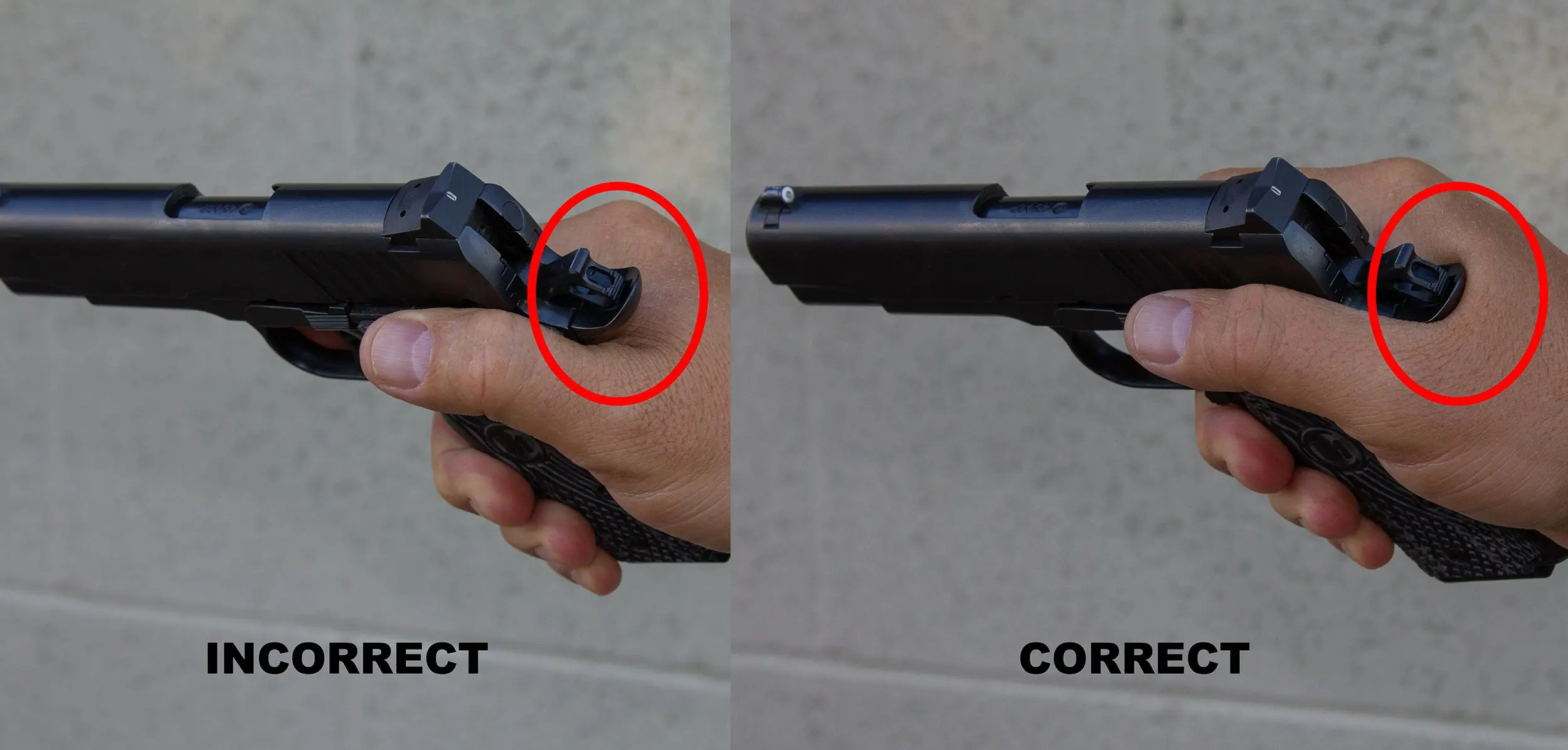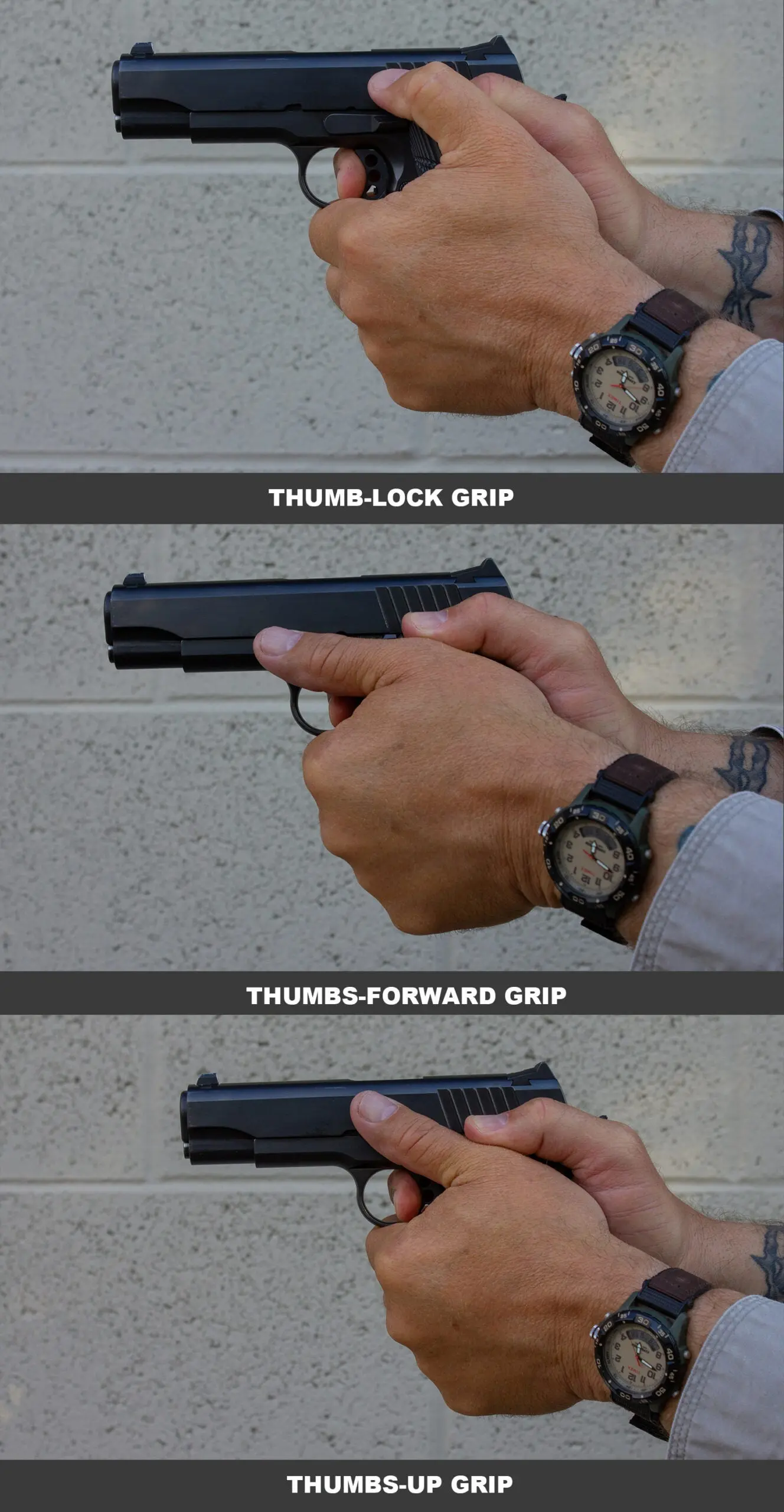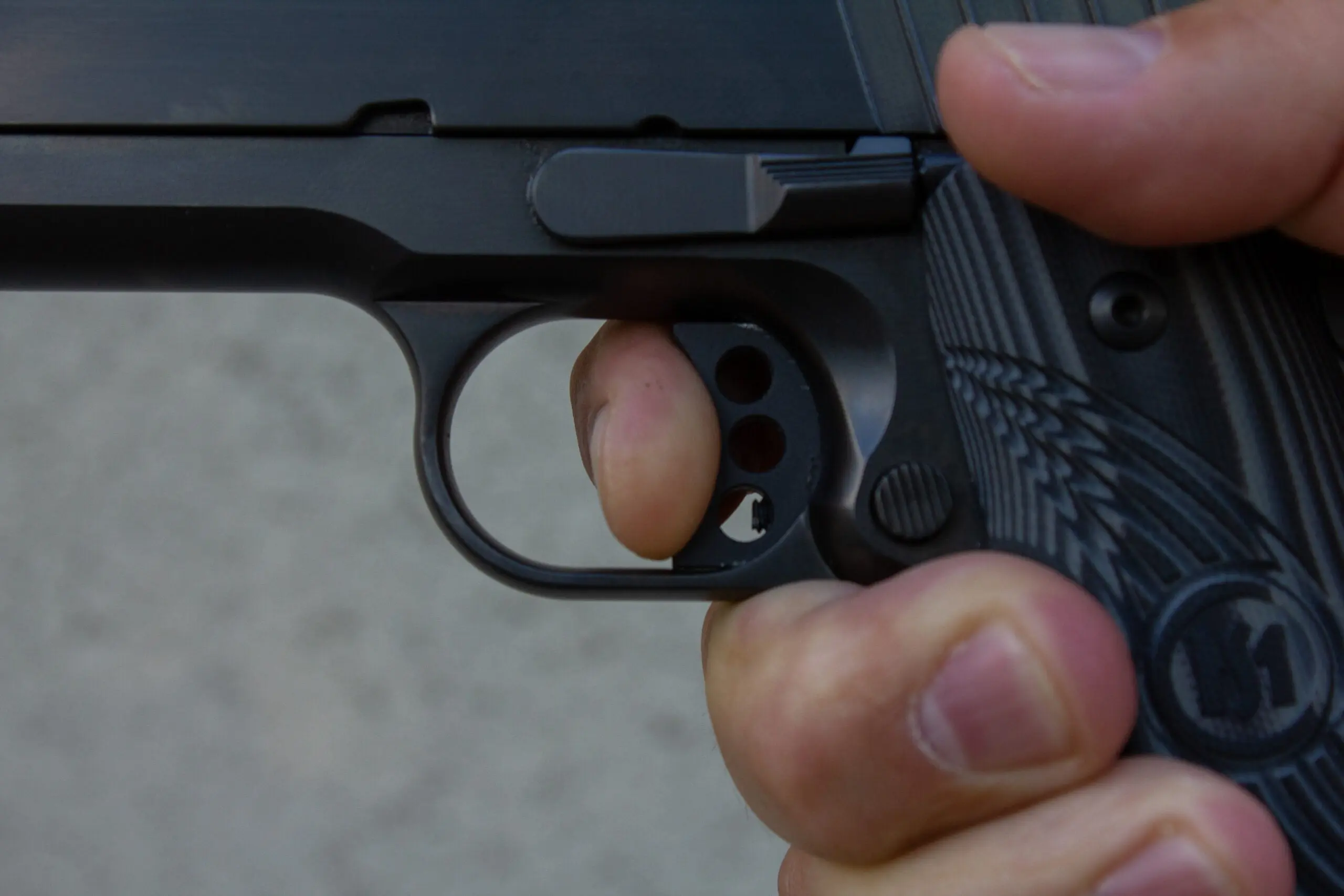_We may earn revenue from the products available on this page and participate in affiliate programs. Learn more ›
_
The secret to shooting a pistol accurately is the simultaneous execution of proper sight alignment and trigger control. But knowing how to hold a pistol is part of that formula. While it is possible to make a good shot with a bad hold on a pistol, it’s dreadfully difficult to make repetitive good shots with a pistol if you’re holding it incorrectly. Here’s how to hold a pistol properly with both hands, and what you need to do from there to shoot accurately.
But before we get going, a quick note of caution: Some people use the words “pistol” and “revolver” interchangeably, but they are not the same, and you do not want to hold a revolver as described below. Doing so could result in injury. What follow applies to pistol’s only. Okay, now let’s get to it.
How to Hold a Pistol: The Shooting Hand

In the left photo, the hand is too low on the grip. You want the webbing of your hand nice and high on the grip to help control recoil. Richard Mann
There are two things you need to get right when you place your shooting hand on a pistol. The first is to make sure that the web of your hand is placed as high on the grip as possible. It should be compressed against the arch of the pistol’s grip. This is important because the pistol’s barrel is positioned above your hand, and during recoil the pistol will rotate at the location where the web of your hand is positioned. A high hold controls recoil better. You grip must be firm, too, but we’ll get to that in a minute.
The second key to how to hold a pistol properly with your shooting hand is to make sure that the barrel is in line (left to right) with your forearm. This helps you naturally point the pistol. To illustrate this, extend your arm with your thumb skyward and point your finger at a target. Now, bend your finger at the first knuckle by about 10 degrees, and try it again. Now, you have to uncomfortably bend your wrist to point at the target. By keeping the handgun in line with your forearm, it allows you to instinctively point the pistol and it also helps you to control recoil better.
How to Hold a Pistol: The Support Hand
You can shoot a pistol with one hand, but you can shoot a pistol better with two. The three best ways to hold a pistol with your support hand are with the thumb-lock grip, the thumbs-up grip, or with the thumbs-forward grip. For all three, place your support hand on the pistol just slightly forward of your shooting hand so the metacarpal thumb bones (the ones in the middle of your thumbs) on each hand are more or less aligned.

All three of these grips work well; it’s mostly a question of personal preference. Richard Mann
For the thumb-lock grip, bend the thumb of your shooting hand at the last joint so the tip of your thumb is pointing slightly downward, and then place the thumb of your support hand on top of it, with light pressure. For the thumbs-forward grip, relax both thumbs and point them toward the target. Thumbs-up grip is very similar, except in this case your support thumb is relaxed and pointed up at about 25 degrees. You point your shooting thumb up slightly to match, or you can use it to apply slight pressure down to the back of your support hand thumb, as show in the photo above.
All these methods of how to hold a pistol with your support hand work equally well, and it’s mostly a matter of personal preference. However, regardless which one you use, most who shoot a pistol with a manual thumb safety prefer to have some light downward pressure on the safety with their shooting thumb to circumvent its unintentional activation. Don’t shoot a pistol with a manual thumb safety with your thumb under the safety.
How Much Grip Force to Use
Once you have your hands correctly positioned, you now need to apply suitable force to control the pistol. You should grip the pistol firmly with both hands but start by squeezing the pistol with your shooting hand until you start to shake a bit. Now, back off with your grip force so everything steadies out. Add your support hand and apply about the same steady pressure or just a bit less. You also need to lock your wrists.
Depending on how big your hands are and how small the pistol is, you may find your support hand partially or even completely covers the trigger guard. That’s OK. You might also discover that your support hand interferes with the pistols slide lock. That’s not OK. Grip is not an exact science, find a grip that’s comfortable, that allows you to control the pistol with firmness and safety, and that allows the pistol to operate as intended.
What to Do with Your Trigger Finger

The pad of the trigger finger should be centered on the trigger so it can be pressed straight back. Richard Mann
Holding a pistol correctly is only part of controlling and shooting it effectively and accurately. Your trigger finger must properly interface with the trigger, and again, the size of the pistol and the size of your hands can influence this. Your trigger finger should be placed on the trigger so that the pad of your finger is centered on the trigger. If you’re a right-handed shooter and you have too much finger on the trigger—if the trigger is near the last joint of your finger—you may pull shots to the right. If you do not have enough finger on the trigger—if the trigger is near the tip of your finger—you may push shots to the left.
How to Hold a Pistol: Putting It All Together
The only way to know if you have a good hold on a pistol is to shoot it and see. You’ll want to see if you can control recoil, if your finger is poisoned correctly to press the trigger straight to the rear, and if you can maintain the same grip through multiple shots—fired bow slow and fast—without interfering with pistol operation. If you cannot do these things, you may need to adjust your grip. If that does not work, you might need to adjust your pistol by fitting different grips
, or by using some or all of the modular grip parts that come with some pistols. But ultimately, how you hold your pistol is a critical point of interface. Get it right, get some training to make it right, or get a new pistol
.






